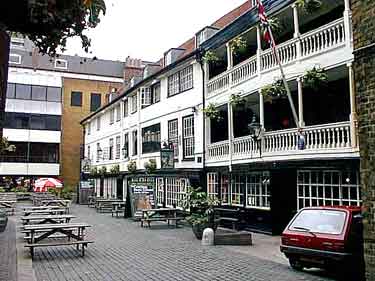|
|

The George
77, Borough High Street, SEI

One of the delights of setting out to explore London is in knowing that the city loves to tease. Like an old coquette, she adds spice to the chase by concealing her treasures in the most unpromising places. Behind the noisy, grimy facade lie all sorts of gems and The George in Southwark easily ranks as an outstanding example.
No more than a few feet from the main road leading to London Bridge, The George is all too easy to miss. For unless it's a weekend, the pace on the pavement is set by office workers who are always in a rush. A turn of the head at the wrong moment and The George stays shielded in its dark courtyard, oblivious to the world beyond its doorstep.
While London has kept a number of its historic pubs and inns The George is unique amongst its peers. It is, in fact, the sole survivor from a number of galleried coaching inns that used to line this route. For centuries, Borough High Street played a crucial role in the life of the city. In one direction, it led to the main crossing point into the capital over the Thames, in the other, it led to Canterbury, the country's principle centre of pilgrimage. As a result, the Borough was a jostling mass of merchants, traders and travellers at every hour of the day and night and, naturally enough, hostelries quickly sprang up to meet their needs.
The Southwark inns had a reputation of their own, becoming so well known that the mere mention of their names conveyed a certain atmosphere and character. The Tabard, for instance, was Chaucer's choice for the starting point of his 'Canterbury Tales' and the White Hart was both Shakespeare's setting for Jack Cade's final plea to his deserting followers in Henry VI Part ii, and Dickens' setting when introducing Sam Weller in Pickwick Papers. The George stood between these two and, like them, was very much part and parcel of a life that often involved arduous journeys in appalling conditions.
The history of The George can be traced back to 1542 although it is likely that an inn existed here for some time before. It is first mentioned as the St. George and the inn sign still sports a portrait of the saint in full battle dress.
Like the other Southwark inns, the George was built around three sides of a courtyard and in Summer its wide, double-tiered balconies became an excellent vantage point for the plays that would be acted out below. Surprisingly, there were no formal theatres before 1576 and taverns provided both an instant showcase and a ready audience for the many troupes of travelling actors. This type of presentation was obviously popular and effective, for when the first theatres were built they were modelled in the same style, the only change being to shape the seating around a semi-circle rather than a rectangle.
With its roots firmly in this tradition, The George can boast with some certainty that Shakespeare was a familiar character when he lived and worked in this area. The playwright not only had lodgings close by, near Southwark Cathedral, but quite probably came to watch performances of his own and other plays here on a regular basis.
The George that Shakespeare knew burnt down in 1676 but the house was immediately rebuilt to the original template. It remained unchanged until the turn of this century, when it was partly demolished for the Great Northern Railway Goods Office. While two of its splendid galleries were destroyed, the broad sweep of the third gives a fair impression of what the whole would have looked like and it takes little imagination to conjure a picture of the past from the shadows of the now quiet courtyard.
Still functioning as a pub and restaurant and even as a stage set for Shakespeare's plays, in Summer time, The George has been restored to its former glory by the National Trust. A remarkable building from the outside, it retains a number of interesting features on the inside too, notably the high pine settles which divide the tables in the smallest of the bars.

The George can be viewed from the outside at almost any time as the courtyard gate is normally left open. The pub and restaurant opening hours are regulated by the landlord.
 London Bridge (Northern Line) London Bridge (Northern Line)
Copyright © Jan Collie 2002
Published by permission of the author.
All rights reserved. No reproduction, copy or transmission of this publication may be made without written permission.
|
|